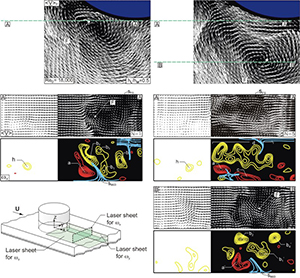You are here
Home ›Three-Dimensional Vortex Formation in the Wake of a Cylinder in Shallow Flow
Three-Dimensional Vortex Formation in the Wake of a Cylinder in Shallow Flow. Fully turbulent shallow flow incident upon a cylinder can give rise to large-scale, quasi-two-dimensional (Kármán-like) vortices in the near-wake region as shown in the top row of images. At the two successive instants represented by these images, the focus F (apparent center) is coincident with the vertical laser sheet at locations A and B. This vortex development is, however, associated with the onset of three-dimensionality in the near-wake region. It is represented by ordered patterns of streamwise vorticity wx, as well as corresponding patterns of instantaneous velocity V, for the aforementioned two successive locations of the focus F of the large-scale vortex formation. In the left column of images, patterns of streamlines corresponding to separation SBED from the bed surface, as well as separation SFS from the free-surface are accompanied by patterns of positive ωx (red) designated as a, as well as negative ωx, corresponding to b1 through b4. Particularly evident is the occurrence of an upward oriented jet-like flow corresponding to the velocity V oriented upward from the bed in conjunction with the saddlepoint SBED. At the later instant, corresponding to the right column of images, the patterns of streamwise vorticity ωx and velocity V on plane B-B, corresponding to the focus F of the primary large-scale vortex, show remarkably similar patterns as in plane A-A at the earlier instant.
Vortex formation in the near-wake of shallow flow past a vertical cylinder can be substantially delayed by base bleed through a very narrow slot. The structure of the wake associated with this delay changes dramatically with the dimensionless momentum coefficient of the slot bleed. At very low values, where substantial vortex delay is attainable, the bleed flow is barely detectable. For progressively larger values, various forms of jets are formed from the slot, and they undergo ordered, large amplitude undulations, not necessarily synchronized with the formation of the large-scale vortices. When the cylinder is subjected to appropriate rotational perturbations, in presence of small magnitude base bleed, it is possible to transform the delayed vortex formation to a form characteristic of the naturally-occurring vortices and, furthermore, to induce a large change of the phase, or timing, of the initially-formed vortex, relative to the cylinder motion. These features of the near-wake structure are assessed via a technique of high-image-density particle image velocimetry, which provides wholefield patterns of vorticity, Reynolds stress, amplitude distributions of spectral peaks, and streamline topology at and above the bed, for both the delayed and recovered states of the wake. Among the findings is that even small bleed can substantially alter the patterns of streamline topology and Reynolds stress at the bed, which has important consequences for the bed loading. These alterations of the near-wake structure occur in conjunction with modifications of the shallow approach flow, which is incident upon the upstream face of the cylinder. The topology at the bed, which is altered in accord with attenuation of the well-defined vorticity concentration of the horseshoe (standoff) vortex, shows distinctive patterns involving new arrangements of critical points.

